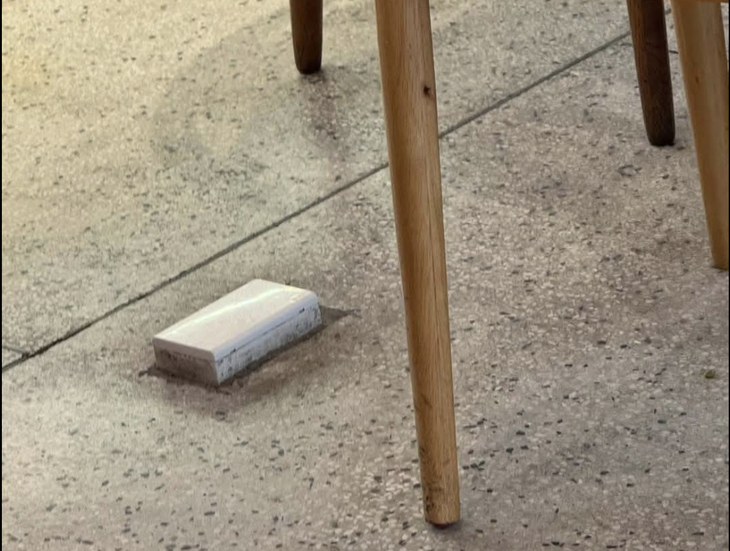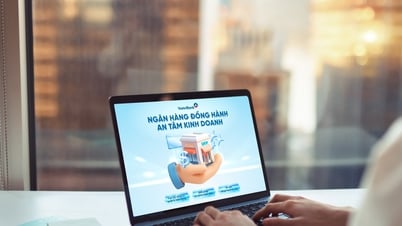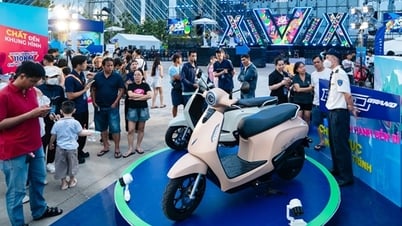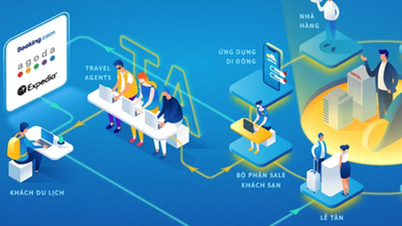
The image of a covered electrical outlet at The Coffee House has caused mixed opinions in recent days - Photo: NHAT XUAN
In recent years, coffee shops have gradually become "mobile offices" and "study corners" instead of just places to meet or have a drink.
Open spaces, free WiFi and a pleasant atmosphere have turned many cafes into ideal places for people to study and work. However, the habit of "staying rooted" all day with just a glass of water is putting many cafe owners in a difficult position.
The owner 'cried out'
After Tuoi Tre Online published the article "Accused of covering electrical outlets to chase away customers who sit for long periods of time, The Coffee House said it was 'making adjustments'" , many readers shared their real-life experiences as well as personal opinions on this issue.
A reader named Tu Ca Mau said he had witnessed many beautiful coffee shops being "occupied" by groups of insurance and real estate employees sitting from morning to afternoon, holding meetings and selling products.
There are also individual customers who occupy an entire table for 4 people, displaying backpacks, laptops, windbreakers... taking up the entire table to design products to sell online...
Reader Nguyen Tuan Loc proposed a tough measure: "Anyone who uses an electrical outlet will be charged an additional 50,000 VND/hour, pay in advance and sign a confirmation. Then collect the remaining amount for the second hour, so both sides get the best out of it."
From the perspective of a business person, some shop owners said they were in a "half-crying, half-laughing" situation when faced with the situation of customers "sitting long but spending little".
Ms. Linh - who runs a coffee shop at home - said that there was a group of insurance employees who came to the shop from 8am to 5pm every day. "The team leader ordered a cup of coffee. The rest just used the iced tea pot, constantly asking for water. Some came to sell, some to consult, some to work on laptops. The cars were parked so close to the door, the lights and fans were running all day to serve," she said in frustration.
On groups, many opinions suggest to restaurant owners "softer" measures to "skillfully chase away" customers who stay too long, such as limiting Wifi connection, cutting off power outlets, or imposing hourly surcharges...
Reader Quang Phu - owner of a coffee shop - shares his experience of "skillfully chasing away" customers: He played Trinh Cong Son's song with the line "Let's go home, there's nothing on earth..." or Nguyen Ngoc Thien's song with the line "Let's go home...".
How to balance profit and customer experience?
However, not everyone sees "stay-at-home" customers as a cost burden. Mr. Nguyen Minh, owner of a coffee shop in District 10 (HCMC), said: "Staying-at-home customers is not necessarily a negative thing. If taken care of well, they can become loyal customers, even creating a "decoy" effect that makes the shop always feel crowded."
He also emphasized that the space and personalized experience are increasingly important. Many people choose coffee shops not only for the drinks, but also for the space, music , and lighting - things that touch their emotions and personalities.
"When customers pay for a cup of coffee, they are paying for the space, service and emotions at the shop. If the shop does not create a good enough experience, customers will not come back," Minh concluded.
Sharing with Tuoi Tre Online , Mr. Do Duy Thanh - Director of FnB Director Consulting Company and Horeca Business School - commented that in the context of the increasingly popular freelance working model, customers choosing coffee shops as "mobile offices" is an inevitable trend and should not be considered a consumable cost.
Instead of restricting or making things difficult, restaurants should take advantage and "behave cleverly" by designing a reasonable menu, adding dishes that easily create consumer demand such as cakes, bottled water or hourly combos.
In addition, consumer data - if used properly - can help personalize the experience, such as suggesting dishes based on ordering history or incentives when customers return during the day.
According to Mr. Thanh, the space of the restaurant should be designed to serve many types of consumer behavior: customers who come to buy take-out, customers who chat briefly, or customers who sit and work for hours. "If only one service model is applied, the restaurant may miss out on potential and create unnecessary pressure on the system," Mr. Thanh analyzed.
"A brand cannot expect customers to be loyal while also sending a message that 'you're sitting too long'. The problem is not how long customers sit, but whether the brand knows how to exploit the value from that behavior," Mr. Thanh emphasized.
Source: https://tuoitre.vn/khach-ngoi-ca-ngay-o-quan-ca-phe-nen-lam-gi-2025052812180582.htm






























![[Photo] National Assembly Chairman attends the seminar "Building and operating an international financial center and recommendations for Vietnam"](https://vphoto.vietnam.vn/thumb/1200x675/vietnam/resource/IMAGE/2025/7/28/76393436936e457db31ec84433289f72)




































































Comment (0)